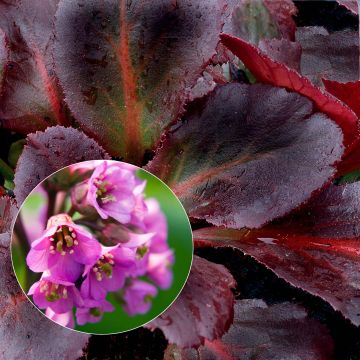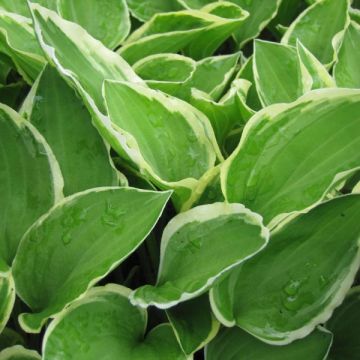

Mini Cyclamen Bisou Violet - Cyclamen hybride
Cyclamen persicum Bisou Violet
Cyclamen x persicum Bisou® Violet
Special offer!
Receive a €20 voucher for any order over €90 (excluding delivery costs, credit notes, and plastic-free options)!
1- Add your favorite plants to your cart.
2- Once you have reached €90, confirm your order (you can even choose the delivery date!).
3- As soon as your order is shipped, you will receive an email containing your voucher code, valid for 3 months (90 days).
Your voucher is unique and can only be used once, for any order with a minimum value of €20, excluding delivery costs.
Can be combined with other current offers, non-divisible and non-refundable.
Why not try an alternative variety in stock?
View all →This plant carries a 12 months recovery warranty
More information
We guarantee the quality of our plants for a full growing cycle, and will replace at our expense any plant that fails to recover under normal climatic and planting conditions.
Would this plant suit my garden?
Set up your Plantfit profile →
Description
Cyclamen Bisou Violet is part of a new line of Persian cyclamen hybrids that combine flame-patterned flowers with heavily silver-marbled foliage. Compact and well-groomed, they form neat cushions that begin flowering in mid-October. This one bears magenta-tinged violet flowers. It is a frost-sensitive plant, but its long flowering period, lasting until the heart of winter, is an undeniable asset for decorating interiors during a time generally unfavourable to blooming. Mini cyclamen is often grown as an annual, in semi-shade or full shade under trees, along pathways, or in shady rockeries where it creates a sensation.
Cyclamen Bisou Violet belongs to the Primulaceae family. It originates from the Persian cyclamen, renowned for its beautiful winter flowering. It is a small perennial plant with tuberous roots, but not very hardy. It is unable to withstand frost. The tubers are rounded and compressed, covered with a smooth and velvety 'skin' as well as roots originating from their centre and base. The vegetative cycle of the cyclamen depends on genetics and growing conditions. In this variety, the dormant period occurs in summer, and the plant begins to grow at the end of summer, flowering from October to January. In frost-free regions, it is possible to leave the tubers in the ground. The leaves are cordate and rounded, measuring about 4cm (2in) in diameter. The colour of the leaves is a dark green in the centre, heavily marbled with silver-grey at the margin. They form a small cushion with a diameter of 25cm (10in). The flowering emerges from the centre of the cushion, at a height of 25cm (10in). The pointed flower buds, initially lying on the ground, stand upright on brown peduncles. Each flower consists of 5 large petals, which are slightly twisted and curved backward. Here, they are violet in colour, finely edged with white. Once the flowering is over, in January, the foliage turns yellow, disappears, and the plant goes dormant. During this resting period, watering should be reduced, and the plant should be stored in a cool place.
Plant in a pot or planter, with a variegated miniature ivy Kolibri, some heucheras, some euphorbias that tolerate semi-shade, or some dwarf euonymus, for example. Planted en masse, with a mix of colours, mini cyclamens form ephemeral but unforgettable carpets in shaded areas of the garden, along with begonias and impatiens, for example. They will also find their place in a semi-shady rockery that is not too dry, along with snowdrops and hellebores, for example. Take a look at our selection of hardy cyclamens, which tolerate cold weather and naturalise in the garden.
Report an error about the product description
Flowering
Foliage
Plant habit
Botanical data
Cyclamen
x persicum
Bisou® Violet
Primulaceae
Cultivar or hybrid
Other Cyclamen
View all →Planting and care
Planting period
Intended location
Care
This item has not been reviewed yet - be the first to leave a review about it.
Similar products
Haven't found what you were looking for?
Hardiness is the lowest winter temperature a plant can endure without suffering serious damage or even dying. However, hardiness is affected by location (a sheltered area, such as a patio), protection (winter cover) and soil type (hardiness is improved by well-drained soil).

Photo Sharing Terms & Conditions
In order to encourage gardeners to interact and share their experiences, Promesse de fleurs offers various media enabling content to be uploaded onto its Site - in particular via the ‘Photo sharing’ module.
The User agrees to refrain from:
- Posting any content that is illegal, prejudicial, insulting, racist, inciteful to hatred, revisionist, contrary to public decency, that infringes on privacy or on the privacy rights of third parties, in particular the publicity rights of persons and goods, intellectual property rights, or the right to privacy.
- Submitting content on behalf of a third party;
- Impersonate the identity of a third party and/or publish any personal information about a third party;
In general, the User undertakes to refrain from any unethical behaviour.
All Content (in particular text, comments, files, images, photos, videos, creative works, etc.), which may be subject to property or intellectual property rights, image or other private rights, shall remain the property of the User, subject to the limited rights granted by the terms of the licence granted by Promesse de fleurs as stated below. Users are at liberty to publish or not to publish such Content on the Site, notably via the ‘Photo Sharing’ facility, and accept that this Content shall be made public and freely accessible, notably on the Internet.
Users further acknowledge, undertake to have ,and guarantee that they hold all necessary rights and permissions to publish such material on the Site, in particular with regard to the legislation in force pertaining to any privacy, property, intellectual property, image, or contractual rights, or rights of any other nature. By publishing such Content on the Site, Users acknowledge accepting full liability as publishers of the Content within the meaning of the law, and grant Promesse de fleurs, free of charge, an inclusive, worldwide licence for the said Content for the entire duration of its publication, including all reproduction, representation, up/downloading, displaying, performing, transmission, and storage rights.
Users also grant permission for their name to be linked to the Content and accept that this link may not always be made available.
By engaging in posting material, Users consent to their Content becoming automatically accessible on the Internet, in particular on other sites and/or blogs and/or web pages of the Promesse de fleurs site, including in particular social pages and the Promesse de fleurs catalogue.
Users may secure the removal of entrusted content free of charge by issuing a simple request via our contact form.
The flowering period indicated on our website applies to countries and regions located in USDA zone 8 (France, the United Kingdom, Ireland, the Netherlands, etc.)
It will vary according to where you live:
- In zones 9 to 10 (Italy, Spain, Greece, etc.), flowering will occur about 2 to 4 weeks earlier.
- In zones 6 to 7 (Germany, Poland, Slovenia, and lower mountainous regions), flowering will be delayed by 2 to 3 weeks.
- In zone 5 (Central Europe, Scandinavia), blooming will be delayed by 3 to 5 weeks.
In temperate climates, pruning of spring-flowering shrubs (forsythia, spireas, etc.) should be done just after flowering.
Pruning of summer-flowering shrubs (Indian Lilac, Perovskia, etc.) can be done in winter or spring.
In cold regions as well as with frost-sensitive plants, avoid pruning too early when severe frosts may still occur.
The planting period indicated on our website applies to countries and regions located in USDA zone 8 (France, United Kingdom, Ireland, Netherlands).
It will vary according to where you live:
- In Mediterranean zones (Marseille, Madrid, Milan, etc.), autumn and winter are the best planting periods.
- In continental zones (Strasbourg, Munich, Vienna, etc.), delay planting by 2 to 3 weeks in spring and bring it forward by 2 to 4 weeks in autumn.
- In mountainous regions (the Alps, Pyrenees, Carpathians, etc.), it is best to plant in late spring (May-June) or late summer (August-September).
The harvesting period indicated on our website applies to countries and regions in USDA zone 8 (France, England, Ireland, the Netherlands).
In colder areas (Scandinavia, Poland, Austria...) fruit and vegetable harvests are likely to be delayed by 3-4 weeks.
In warmer areas (Italy, Spain, Greece, etc.), harvesting will probably take place earlier, depending on weather conditions.
The sowing periods indicated on our website apply to countries and regions within USDA Zone 8 (France, UK, Ireland, Netherlands).
In colder areas (Scandinavia, Poland, Austria...), delay any outdoor sowing by 3-4 weeks, or sow under glass.
In warmer climes (Italy, Spain, Greece, etc.), bring outdoor sowing forward by a few weeks.



















































